Stance phase Study guides, Class notes & Summaries
Looking for the best study guides, study notes and summaries about Stance phase? On this page you'll find 813 study documents about Stance phase.
Page 4 out of 813 results
Sort by
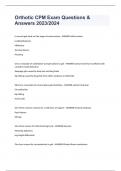
-
Orthotic CPM Exam Questions & Answers 2023/2024
- Exam (elaborations) • 18 pages • 2023
-
- $9.99
- + learn more
Orthotic CPM Exam Questions & Answers 2023/2024 In normal gait what are the stages of stance phase - ANSWER-Initial contact Loading Response Midstance Terminal Stance Preswing Give an example of substitution (compensation) in gait - ANSWER-Lateral trunk lean to affected side caused by weak abductors Steppage gait caused by drop foot and long limbs Hip Hiking caused by long limb from either weakness or deformity What are 4 examples of coronal plane gait deviations - ANSWER-Lat...
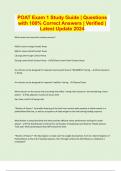
-
POAT Exam 1 Study Guide | Questions with 100% Correct Answers | Verified | Latest Update 2024
- Exam (elaborations) • 12 pages • 2023
- Available in package deal
-
- $12.49
- + learn more
What causes the most skin contact pressure? A)Short Levers+Large Contact Areas B)Short Levers+Small Contact Areas C)Long Levers+Large Contact Areas D)Long Levers+Small Contact Areas - B) Short Levers+Small Contact Areas An orthosis can be designed for impaired muscle performance *WEAKNESS* during: - Foot clearance in Swing An orthosis can be designed for impaired *stability* during: - Stance Phase What muscles on the stance limb and swing limb affect *swing limb clearance* and maintainin...
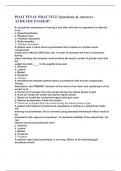
-
POAT FINAL PRACTICE Questions & Answers ALREADY PASSED!!
- Exam (elaborations) • 17 pages • 2023
-
- $16.49
- + learn more
POAT FINAL PRACTICE Questions & Answers ALREADY PASSED!! A non-painful awareness of having a foot after that foot is amputated is referred to as : a. Hyperkinesthesia b. Phantom Pain c. Phantom Sensation d. Radiculopathy C. Phantom sensation A patient uses a trans femoral prosthesis that contains an ischial ramus containment socket and a Mauch SNS knee unit. In order to maintain the knee in extension during static standing, the amputee must position the body's center of gravity such ...
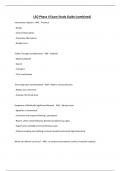
-
LEO Phase II Exam Study Guide (combined)
- Exam (elaborations) • 57 pages • 2023
- Available in package deal
-
- $12.99
- + learn more
LEO Phase II Exam Study Guide (combined) Intervention Options - ANS-- Presence - Dialog - Control Alternatives - Protective Alternatives - Deadly Force Follow Through Considerations - ANS-- Stabilize - Monitor/Debrief - Search - Transport - Turn over/release Three Approach Considerations - ANS-- Make a contact decision - Deploy your resources - Evaluate the threat level Symptoms of Medically Significant Behavior - ANS-- Abrupt onset - Agitation or excitement - Confusion and impai...
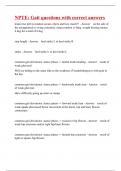
-
NPTE: Gait questions with correct answers
- Exam (elaborations) • 8 pages • 2023
- Available in package deal
-
- $11.49
- + learn more
transverse pelvis rotation occurs where and how much?? - Answer on the side of the unsupported or swing extremity. mean rotation is 4deg. weight bearing rotates 4 deg for a total of 8 deg step length - Answer heel strike L to heel strike R strike - Answer heel strike L to heel strike L common gait deviations: stance phase--> lateral trunk bending - Answer result of weak glut med Will see beding to the same side as the weakness (Trendelenburg) or with pain in the hip c...
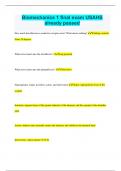
-
Biomechanics 1 final exam USAHS already passed
- Exam (elaborations) • 10 pages • 2024
- Available in package deal
-
- $9.99
- + learn more
Biomechanics 1 final exam USAHS already passed How much dorsiflexion is needed to navigate stairs? What about walking? Walking- neutral; Stairs 20 degrees What nerve innervates the dorsiflexors? Deep peroneal What nerve innervates the plantarflexors? Tibial nerve Supraspinatus origin, insertion, action, and innervation Origin: supraspinous fossa of the scapula Insertion: superior facet of the greater tubercle of the humerus and the capsule of the shoulder joint Action: abducts and externall...
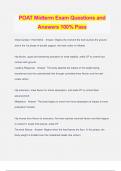
-
POAT Midterm Exam Questions and Answers 100% Pass
- Exam (elaborations) • 30 pages • 2024
-
- $12.49
- + learn more
POAT Midterm Exam Questions and Answers 100% Pass Initial Contact / Heel Strike - Answer- Begins the moment the foot touches the ground and is the 1st phase of double support, the heel rocker is initiated Hip flexion, quad and hamstring activation for knee stability, ankle DF to control foot contact with ground Loading Response - Answer- The body absorbs the impact of the weight being transferred onto the outstretched limb through controlled knee flexion and the heel rocker action Hip e...
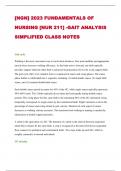
-
NGN) 2023 FUNDAMENTALS OF NURSING (NUR 211) GAIT ANALYSIS SIMPLIFIED CLASS NOTES
- Class notes • 15 pages • 2023
- Available in package deal
-
- $17.99
- + learn more
(NGN) 2023 FUNDAMENTALS OF NURSING (NUR 211) GAIT ANALYSIS SIMPLIFIED CLASS NOTES Gait cycle Walking is the most convenient way to travel short distances. Free joint mobility and appropriate muscle force increases walking efficiency. As the body moves forward, one limb typically provides support while the other limb is advanced in preparation for its role as the support limb. The gait cycle (GC) in its simplest form is comprised of stance and swing phases. The stance phase further is...
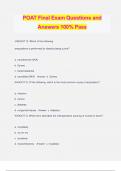
-
POAT Final Exam Questions and Answers 100% Pass
- Exam (elaborations) • 30 pages • 2024
- Available in package deal
-
- $14.49
- + learn more
POAT Final Exam Questions and Answers 100% Pass KAHOOT Q: Which of the following amputations is performed by disarticulating a joint? a. transfemoral (AKA) b. Symes c. transmetatarsal d. transtibial (BKA) - Answer- b. Symes KAHOOT Q: Of the following, which is the most common cause of amputation? a. infection b. cancer c. diabetes d. congenital issues - Answer- c. diabetes KAHOOT Q: Which term describes the interoperature suturing of muscle to bone? a. myoplasty b. my oh my c. my...
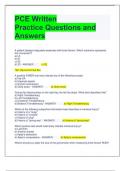
-
PCE Written Practice Questions and Answers
- Exam (elaborations) • 30 pages • 2023
-
Available in package deal
-
- $13.49
- + learn more
PCE Written Practice Questions and Answers A patient displays fatiguable weakness with knee flexion. Which myotome represents this movement? a) L5 b) S1 c) S2 d) S3 - ANSWER c) S2 *S2: Hip ext & Knee flex A positive FABER test may indicate any of the following except: a) Hip OA b) Iliopsoas spasm c) SI joint involvement d) Glute strain - ANSWER d) Glute strain During the stance phase on the right leg, the left hip drops. What best describes this? a) Right...



